Combat Lasers — The Weapons of Science Fiction Become Reality : A Well Thought Out Scream by James Riordan

“Set your phasers on stun,” Captain James T. Kirk of the Starship Enterprise would bark at his crew, but we all knew he meant “lasers” instead of “phasers” because lasers were the weapon of the future. When Auric Goldfinger flipped on his superlaser that was burning and cutting through solid steel towards a spread-eagled James Bond all  of us guys winced. To have the ultimate hand-to-hand combat weapon sizzling toward your private parts was cringe-worthy stuff. Of course Bond somehow turned thecourse Bond somehow turned the tables on Auric and everyone in the Star Trek crew (except the guys in the red shirts) survived and we wondered if lasers were ever really going to be used as a weapon. They were being used effectively in Medical applications, printing, CDs and optical discs, welding and cutting, surveying, the garment industry, communications, spectroscopy, heat treatment, and barcode scanners. We even have laser cooling. But, hey this is America, if we can do all that with lasers how come we’re not killing anybody with them? Well, rest assured, that day has come. Lockheed Martin, the mega defense contractor, Notre Dame University, DARPA (Defense Advanced Research Projects Agency) and the Air Force Research Lab have begun flight testing a streamlined and greatly miniaturized airborne laser turret that has the potential to totally transform air combat as we understand it today.
of us guys winced. To have the ultimate hand-to-hand combat weapon sizzling toward your private parts was cringe-worthy stuff. Of course Bond somehow turned thecourse Bond somehow turned the tables on Auric and everyone in the Star Trek crew (except the guys in the red shirts) survived and we wondered if lasers were ever really going to be used as a weapon. They were being used effectively in Medical applications, printing, CDs and optical discs, welding and cutting, surveying, the garment industry, communications, spectroscopy, heat treatment, and barcode scanners. We even have laser cooling. But, hey this is America, if we can do all that with lasers how come we’re not killing anybody with them? Well, rest assured, that day has come. Lockheed Martin, the mega defense contractor, Notre Dame University, DARPA (Defense Advanced Research Projects Agency) and the Air Force Research Lab have begun flight testing a streamlined and greatly miniaturized airborne laser turret that has the potential to totally transform air combat as we understand it today.
For the last few years there have been heavy 10-30 kilowatt combat lasers tested on a Navy ship and an army truck about the size of an 18 wheeler. Those were vehicles chosen to carry the heavy weight of the lasers and their power systems. Now there is an $26 million air force project for a 50+ kilowatt combat laser on an F15 and another $18 million project for a high altitude anti-missile drone by 2021. The flying combat lasers have to be far lighter. By 2021 the lasers should also have power increased to 150 kilowatts or more. Over the last 25 years the US military has spent about $8 billion developing combat lasers but none have been put into production. The military lasers are riding the widespread …
Over the last 25 years the US military has spent about $8 billion developing combat lasers but none have been put into production. The military lasers are riding the widespread use of 10 kilowatt industrial cutting and welding lasers and the lasers for telecommunications.
Lockheed’s new Laser Super Turret could change air combat forever. This new state-of-the-art beam control turret allows for 360 degree aiming coverage for directed energy weapons that will be flying on military aircraft in the not so distant future. In other words, this turret is able to rapidly aim at targets and focus a directed energy burst through the atmosphere at those targets to disable or destroy them, all while flying on a aircraft barreling through the sky at high-speed.
Known as the Aero-Adaptive, Aero-Optic Beam Control, or just ABC for short, Lockheed’s new wonder-turret has been installed on an elderly Dassault Falcon 10 business jet for preliminary flight testing. According to Lockheed, the Aero-Adaptive part of the ABC turret relates to atmospheric turbulence compensation technologies that are integrated into it. Lockheed’s press release explains:
The ABC turret system is designed to allow high-energy lasers to engage enemy aircraft and missiles above, below and behind the aircraft. Lockheed Martin’s flow control and optical compensation technologies counteract the effects of turbulence caused by the protrusion of a turret from an aircraft’s fuselage.
So basically, the system can sense the turbulence in the atmosphere where it is aiming and it can rapidly compensate for that turbulence so that the high-power laser does not become unfocused as it travels through that atmosphere, which would greatly limit its range. According to some sources, ABC can actually pull this off when shooting at incoming missiles that are approaching from behind, in back of the highly disturbed air caused by the aircraft’s jet exhaust.
In June 2017, the U.S. Missile Defense Agency (MDA) released a solicitation demonstrating interest in the defense industry’s capability to produce a High Altitude Long Endurance (HALE) unmanned aircraft that can carry high energy laser system for boost phase intercept. MDA’s listing listed several requirements for this boost-phase capability including: 1. on-station altitude of greater than 63,000 ft, 2. flight endurance of greater than 36 hours, 3. flight cruise speed of less than Mach 0.45 at altitude, and 4. a payload capacity of at least 5,000 lbs and as much as 12,500 lbs.
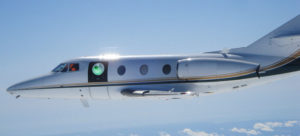 Drones on Lasers can be the holy grail of missile defense Boost phase missile defense is destroying an enemy missile during the earliest stages of its flight, while it remains within the Earth’s atmosphere. A viable boost phase defense has long been considered the “holy grail” of BMD (ballistic missile defense), as boosting missiles are much slower and easier to track than missiles during the midcourse or terminal stage, which makes them more vulnerable to interception. Boost phase defense also overcomes the challenges of discriminating between lethal warheads and debris, as the missile is largely intact at this stage and has not had the opportunity to deploy decoys. Early intercept during the boost phase also has the added benefit of causing the missile’s ordinance to fall back on the aggressor after the boosters have been disabled or destroyed.
Drones on Lasers can be the holy grail of missile defense Boost phase missile defense is destroying an enemy missile during the earliest stages of its flight, while it remains within the Earth’s atmosphere. A viable boost phase defense has long been considered the “holy grail” of BMD (ballistic missile defense), as boosting missiles are much slower and easier to track than missiles during the midcourse or terminal stage, which makes them more vulnerable to interception. Boost phase defense also overcomes the challenges of discriminating between lethal warheads and debris, as the missile is largely intact at this stage and has not had the opportunity to deploy decoys. Early intercept during the boost phase also has the added benefit of causing the missile’s ordinance to fall back on the aggressor after the boosters have been disabled or destroyed.
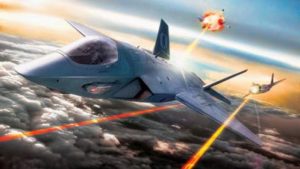 Directed energy technology—or lasers—is the most sought-after future boost phase missile defense option. The US Navy is requesting 60-85 million each year for the next few years to develop more powerful combat lasers. It is called project HELIOS. A follow on system originally called SNLWS (surface navy laser weapon system) Increment 2 would boost the power of the lasers to 150-300 kilowatts which is enough to engage cruise missiles. An eventual increment 3 would boost power to 500+ Kilowatts to engage cruise missiles fired directly at a ship. The entire DOD will have a directed energy weapon roadmap in early 2018. Fast speed and distance to hit North Korean ICBMs would likely need megawatt lasers. Having good targeting with 300 Kilowatt lasers could allow 3-5 drones to combine laser power on a common target. Alternatively the multiple 300 kilowatt systems could be combined to reach megawatt power. This will mean having systems that are 3-4 times bigger.
Directed energy technology—or lasers—is the most sought-after future boost phase missile defense option. The US Navy is requesting 60-85 million each year for the next few years to develop more powerful combat lasers. It is called project HELIOS. A follow on system originally called SNLWS (surface navy laser weapon system) Increment 2 would boost the power of the lasers to 150-300 kilowatts which is enough to engage cruise missiles. An eventual increment 3 would boost power to 500+ Kilowatts to engage cruise missiles fired directly at a ship. The entire DOD will have a directed energy weapon roadmap in early 2018. Fast speed and distance to hit North Korean ICBMs would likely need megawatt lasers. Having good targeting with 300 Kilowatt lasers could allow 3-5 drones to combine laser power on a common target. Alternatively the multiple 300 kilowatt systems could be combined to reach megawatt power. This will mean having systems that are 3-4 times bigger.
This technology is broadly known as ‘adaptive optics.’ Similar systems that use a laser to sense disturbances in the atmosphere between a system’s optics and its target, and which utilizes an adaptive or ‘deformable’ mirror technology to compensate for it, have been used by cutting edge observatories, the Airborne Laser program, and other larger laser systems prior to this new and highly miniaturized laser turret’s arrival.
At first, operational versions of this turret will most likely be installed on bombers, very large drones and converted cargo aircraft like the AC-130 gunship. But soon after, this system, or a slightly miniaturized version of it, will be mounted on fighter aircraft and tactical-sized unmanned combat air vehicles (UCAVS).
Combat lasers are here…and these babies are not set on stun.



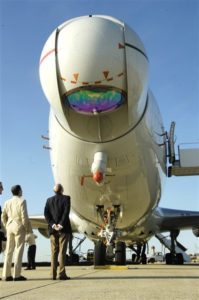
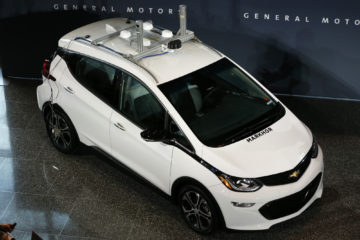
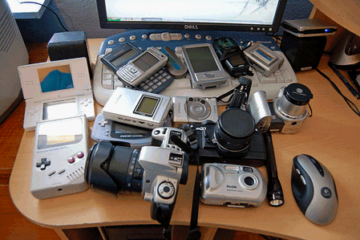

No Comment